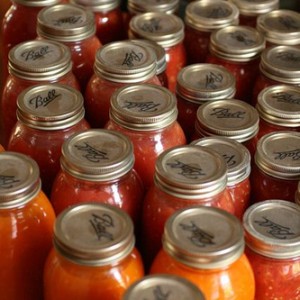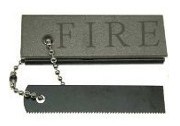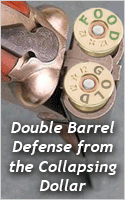 Disaster Prep On A Budget by Dennis Evers- Disaster Prep can be expensive, particularly if you spend a small fortune on dedicated “survival” items that may or may not be used. Preparing makes good common sense, and on so many levels. There are natural disasters by the dozens, man made emergencies like chemical spills, riots, terrorism, crime and on and on. Add economic problems like high unemployment and those associated with cities laying off law enforcement and other emergency services due to budget problems and you have the perfect storm looming on the horizon.
Disaster Prep On A Budget by Dennis Evers- Disaster Prep can be expensive, particularly if you spend a small fortune on dedicated “survival” items that may or may not be used. Preparing makes good common sense, and on so many levels. There are natural disasters by the dozens, man made emergencies like chemical spills, riots, terrorism, crime and on and on. Add economic problems like high unemployment and those associated with cities laying off law enforcement and other emergency services due to budget problems and you have the perfect storm looming on the horizon.
Picture Credit: From The Bitten Word on Flicker
Most of us living within our means have a limited amount of discretionary income for prepping. With that in mind, preparing on a budget is important and purchasing inexpensive yet functional as well as multi-use items that can be used on a regular basis as well will help stretch every penny you spend.
Let There be Light
One of the most important accessory in every disaster kit is some sort of light. Light is necessary to work and navigate by, but psychologically, it is essential to help mitigate some of the fear associated with disasters and power outages.
While a good LED light can easily run thirty or more dollars, and needs to be recharged either by crank, solar or wall power, the thought of putting one in each room is cost prohibitive. It would be nice to have an easily charged LED with long run times, and the ability to recharge several hundred times without losing their punch.
It sounds impossible, but there are several lights from one to three dollars that fit the bill in the form of solar garden path lights. While they don’t put out tons of light, they provide enough light to navigate around a dark house and work as a flashlight or reading light in a pinch. They can be recharged in the window sill in the daytime and will run 8-10 hours every night. I recently purchased several at a local superstore for $1.00 each! Ten bucks worth allows you to put one in every room and several in the main gathering area. Now granted, they aren’t nearly as bright (or as expensive) as a battery operated lantern, but they are safer than a candle, and have the ability to recharge themselves. In short, they are not designed for emergency use, but work incredibly well for it.
The same thing holds true with certain types of food. Dehydrated food like instant potatoes, macaroni and cheese, ramen, and hundreds of other products can be integrated into your supply and rotated out while being replaced with fresh ones. Drinks like Tang and powdered lemonade will store indefinitely and would be a welcome addition to any meal during times of trouble. Another advantage is, if you use the foods you store you will have less of a shock if trouble hits. A little thing called “food fatigue” can easily cause you to lose your edge if you end up eating peanut butter for every meal because that’s all you have in the pantry. Canned foods are terrific for affordable disaster prep. The following excerpt from the Food and Drug administration is a remarkable example of foods storage ability.
“The steamboat Bertrand was heavily laden with provisions when it set out on the Missouri River in 1865. The boat snagged and swamped under the weight, sinking to the bottom of the river. It was found a century later, under 30 feet of silt a little north of Omaha, Neb.
Among the canned food items retrieved from the Bertrand in 1968 were brandied peaches, oysters, plum tomatoes, honey, and mixed vegetables. In 1974, chemists at the National Food Processors Association (NFPA) analyzed the products for bacterial contamination and nutrient value. Although the food had lost its fresh smell and appearance, the NFPA chemists detected no microbial growth and determined that the foods were as safe to eat as they had been when canned more than 100 years earlier”.
We regularly ate ten year old canned goods at grandma’s house with out side effects. (It did finally catch up to her at 103, God rest her soul.)
Water can be purchased in cases, used and rotated regularly, or you can put in gallon jugs and forget about them. Mayday industries has a clever water filter that fits over your water heater allowing you to access and drink the 40 or more gallons stored inside.
Hygiene can be a real challenge, but a roll of heavy duty trash can liners can have numerous uses. If your sewer is down as is common after an earthquake, flooding or power outage, you can line the toilet with a bag and when it is full, change it out. A couple of large trash cans can hold the waste until service is restored. Several boxes of wet ones will allow you maintain basic hygiene as well. A bottle of regular unscented bleach is another dirt cheap, yet invaluable item.
When you go the store, take time and think about alternative uses for some of the items you need. If you can get twice as much for a little more, do it. The vast majority of products charge an absolute premium for small or individual quantities. Worse case scenario is you end up more than you can use, but you can donate it to a food bank before it expires or give it to your brother-in-law.
While no one knows what the future may bring, preparing now might go a long way in the near future. There are hundreds of aspects to preparing and this is only a tiny fraction, but hopefully it allows you to think outside the box when it comes to affordable disaster prep.
Dennis Evers is a former police chief and best selling author. His newest book, “How to Handle a Crisis” will be available soon at howtohandleacrisis.com.






















